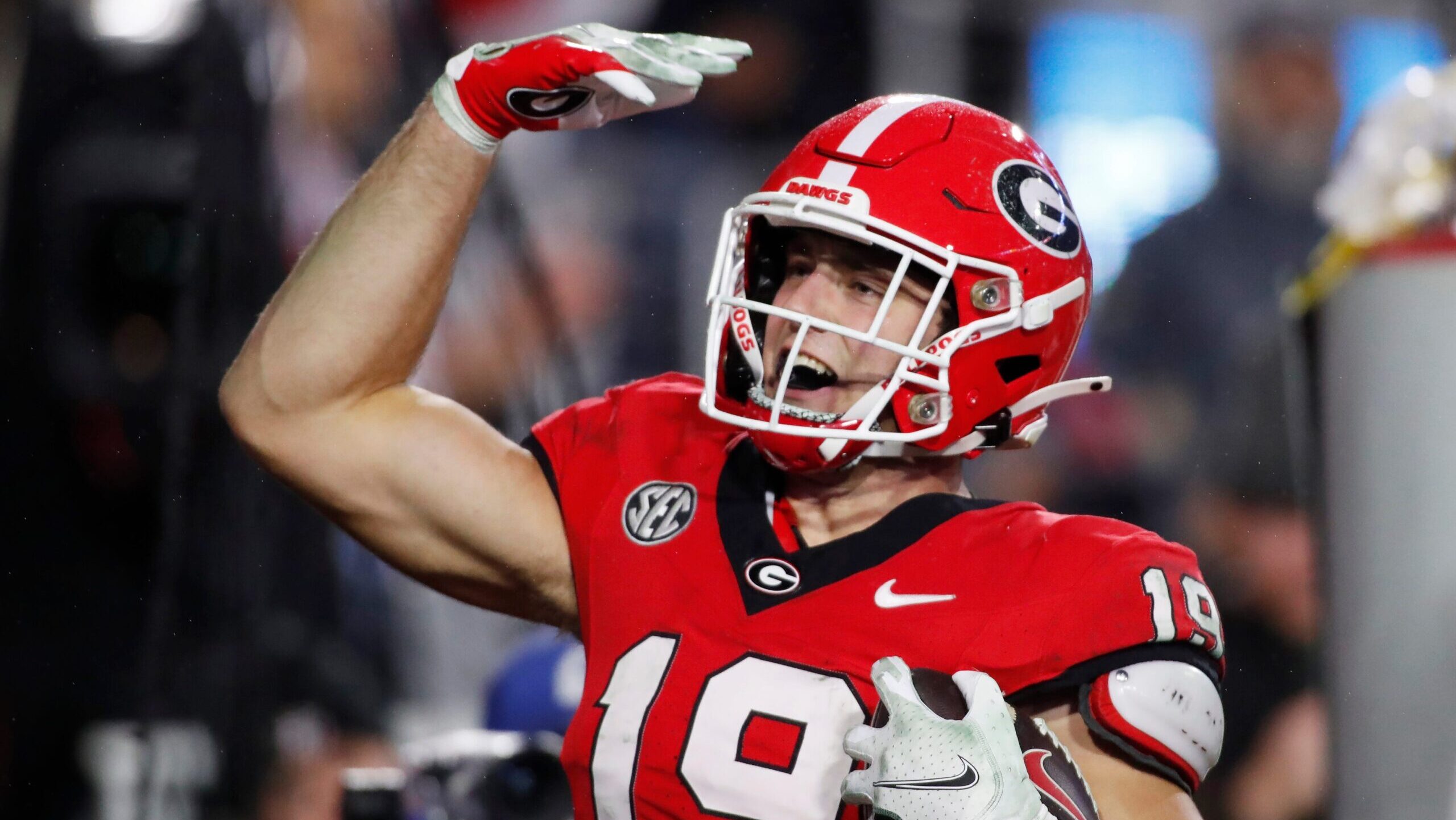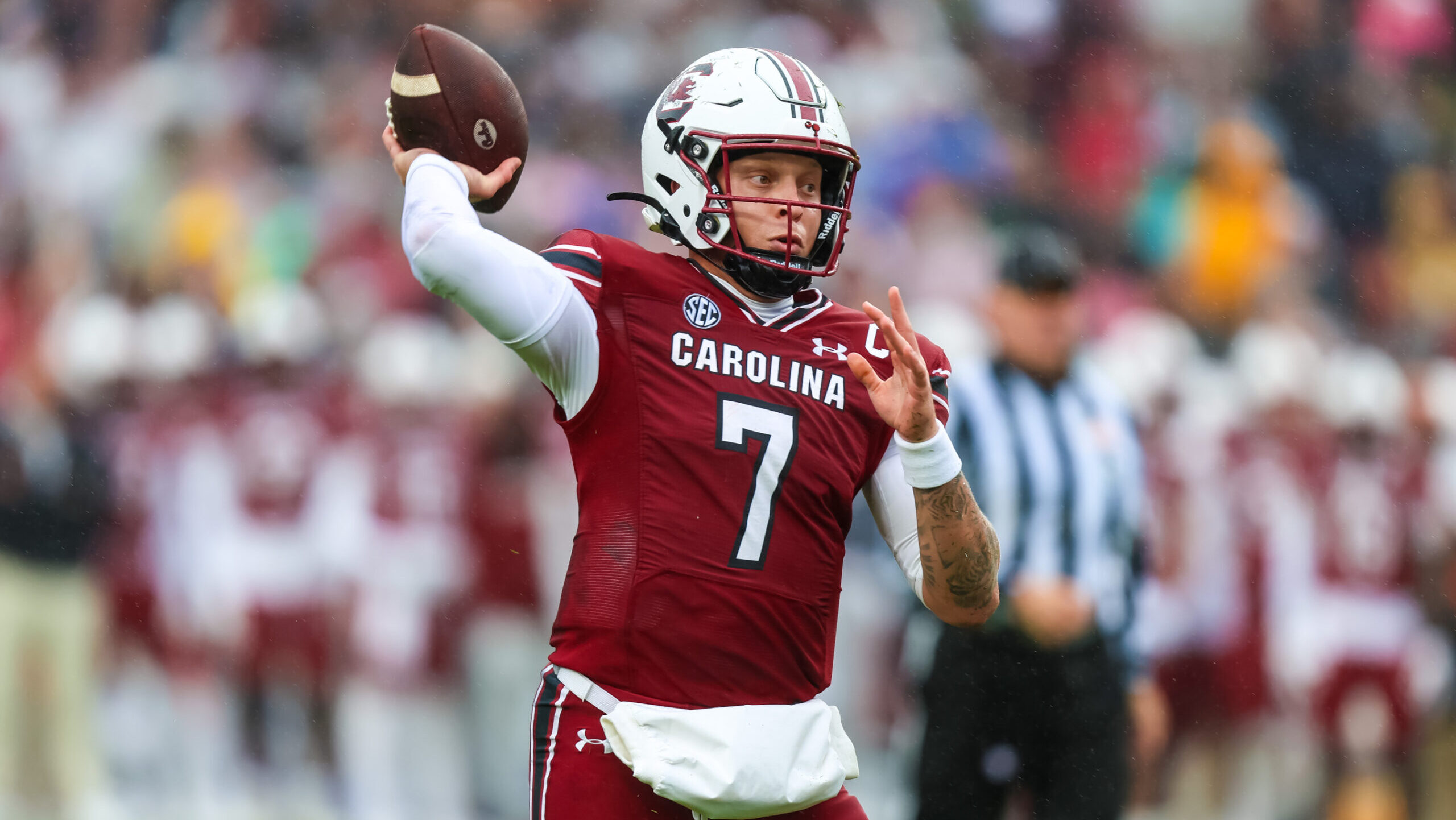Analysis
8/26/22
12 min read
How Injuries and Schedule Affect NFL Team's Records
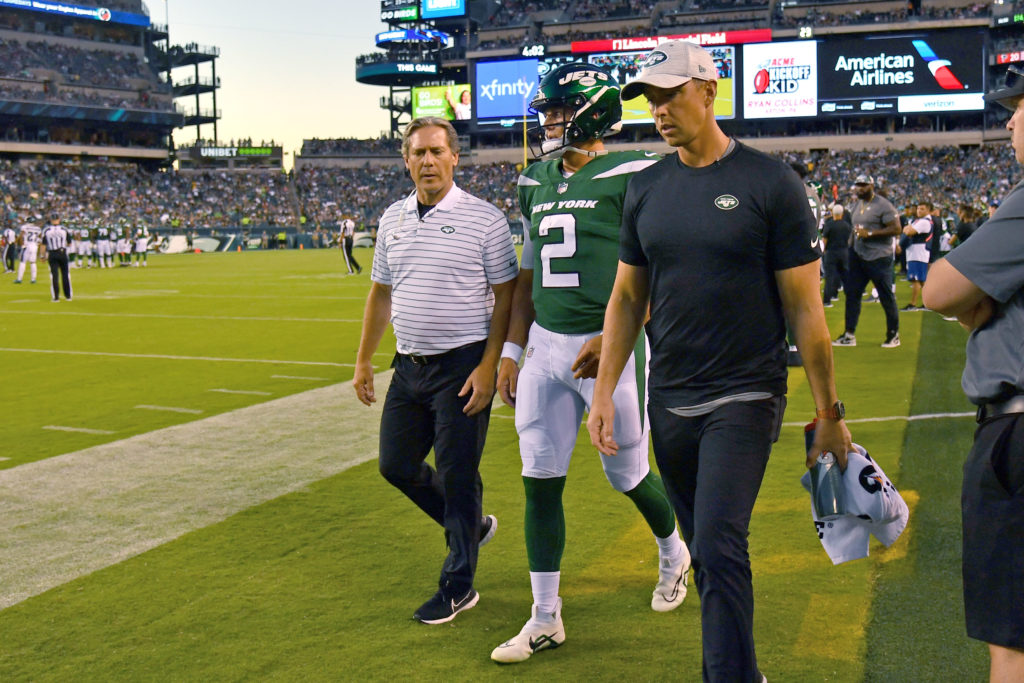
In 2021, the New York Jets had a difficult combination of factors that have little to do with talent or Xs and Os. Last year, the Jets played twelve games against teams that ended the season with a winning record, and only five games against teams with a losing record.
On the injury front, the Jets lost many key players including Mekhi Becton, Corey Davis, Zach Wilson, Michael Carter, Elijah Moore, Marcus Maye, Jarrad Davis and Bryce Huff for a significant part of the season. They were the second-most injured team according to Football Outsiders Adjusted Games Lost metric. The 4-13 Jets lacked the talent to have a winning record, but things outside of their control also heavily contributed to their disappointing season.
The 10-7 Cincinnati Bengals, who were minutes away from winning the Super Bowl last season, had the easiest schedule in 2021 according to Pro Football Reference’s Strength of Schedule rating. Their schedule—combined with the seventh-fewest Adjusted Games Lost to injury—gave the Bengals an easier path to the playoffs than most teams.
However, once the schedule toughened up in the playoffs, they peaked when it mattered the most by beating three strong teams (two on the road). With a tougher schedule and/or worse injury luck would the Bengals have won enough in the regular season to make the playoffs?
There are many reasons why teams improve or decline from year-to-year. The newer 17-game schedule (previously 16 games) allows for a higher level of variance from season to season. Both luck and uncontrollable factors play a large role in determining a team’s record in a league designed for parity.
Many variables outside of players, coaching and strategy play a role in determining a team’s record. In this article, we focus on two of them: injuries and strength of schedule.
Collecting Data
The chart below places teams into one of four quadrants based on their schedule strength, and their injury luck in 2021. There are multiple ways to determine injury luck and strength of schedule, but we are using Pro Football Reference for their Strength of Schedule metric, which is the average point differential of each team’s opponents.
Note: A small part of the schedule strength is self-fulfilling, for example, the Bills get to play the Jets, but the Jets don’t play the Jets. We are using Football Outsiders AGL metric for injury luck.
The quadrants are split by the average SOS, which is 0.0, and the 2021 median for a team's adjusted games lost (AGL) of 81.8. Theoretically, the teams in the top-right quadrant had the most difficult path in 2021; the further away from the center in this quadrant the unluckier the team is.
Teams such as the Jets and Ravens were up against very difficult circumstances. Others in the lower-left quadrant had the easiest path. Teams such as the Bills, Bengals and Dolphins had a much easier path than the rest of the league. Regardless of the quadrant, teams close to the center like the Texans, Packers and Browns had fairly average luck. The number of wins for each team is represented by the bubble size.
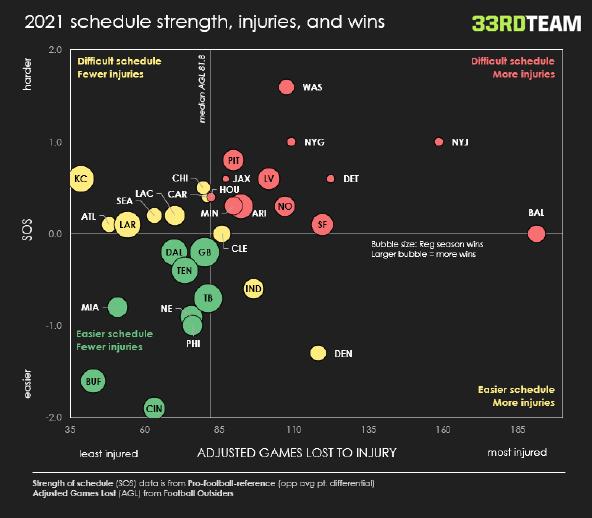
It's no coincidence the smallest bubbles are in the most difficult quadrant. Having above-average injuries and playing a difficult schedule makes it harder to win games, so it makes sense this quadrant would have teams with fewer wins. In 2021, teams in the difficult quadrant averaged 7.3 wins. The opposite occurs in the easy quadrant where the average team in 2021 won 10.8 games, in part due to an easier schedule and fewer injuries.
To get a more accurate picture of how these two variables affect a team’s success, we looked at four years’ worth of data. With data points coming from 32 teams across four seasons, we can eliminate some of the unpredictability of using a one-year sample size. During the last four seasons, teams in the most difficult quadrant averaged 3.6 more wins per season than teams in the easiest quadrant (adjusted for a 17-game schedule). 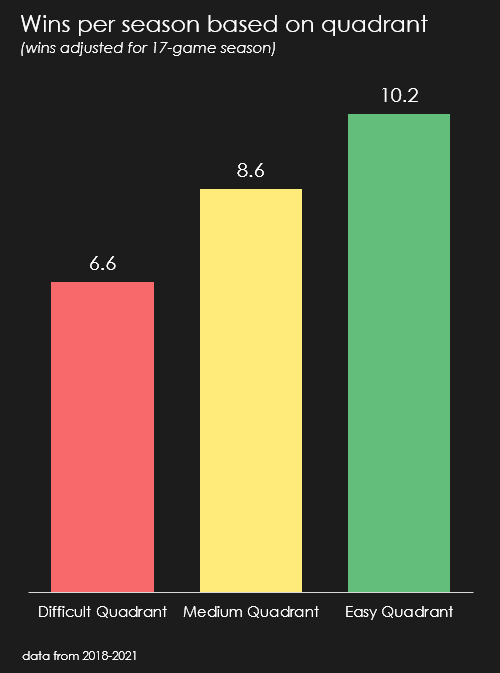
The Big Picture
The 33rd Team’s Bill Parcells once famously said “You are what your record says you are.”
While technically true, it can be argued a team’s record doesn’t always represent their true roster talent and coaching acumen. A team with a .500 roster might end up 10-7 if they’re in the easy quadrant and 7-10 if they’re in the difficult quadrant.
Next season, the very best teams in the league regress, and the worst teams improve. This is in part, caused by external factors, aka luck, which can make good teams become great and bad teams become the worst. These factors such as injuries, schedule, turnover luck and record in close games are not always predictable or repeatable.
Does this mean a team in the easy quadrant is more likely to have a worse record the next season, and a team with a difficult path is likely to improve?
Here is what four years of data tell us: Teams from the difficult quadrant show an increase of 1.1 wins in the next year. But teams in the easy group don’t give much indication of significant regression in their records, showing only a moderate -0.3 change in wins the following season. 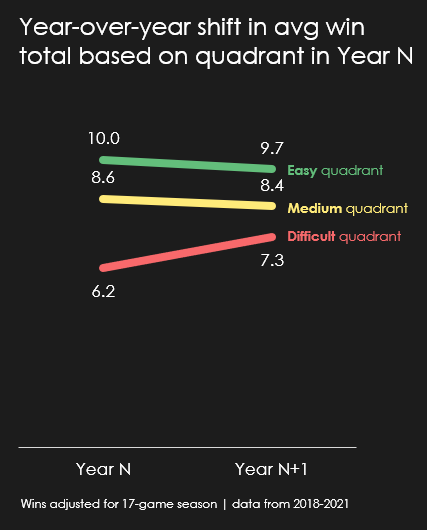
A year-over-year comparison of wins based on quadrants in the previous year without the context of their placement on the chart the next year, only tells one-half of the story.
What’s missing from the high-level data above is the understanding that teams don’t automatically have different luck the next season. The strength of schedule can be slightly predictable given that 35% of a team’s schedule is against the same division each year. It’s plausible a team’s field surface or training staff can have some influence on injury rates as well.
For more context, it’s important to look at how often teams leave their quadrant the next year and what happens to their record when they do. We found a high percentage of teams remain in their quadrant the next year. From 2018-2021, 40% of teams in the difficult group stayed in the difficult group. This number was 38% for the easy group and 57% for the medium group.
However, when teams do change quadrants from one year to the next, their win totals will shift in a predictable pattern. Moving to an easier quadrant will lead to more wins and moving to a more difficult quadrant will lead to fewer wins—they will shift even more when moving from one extreme to the other (Difficult to Easy and Easy to Difficult, skipping the medium quadrant).
Here are the average year-over-year win shifts for teams moving from one quadrant to another. (Adjusted for a 17-game season).
- Difficult to medium – increase of 1.3 wins
- Difficult to easy - increase of 1.6 wins
- Medium to easy – increase of 1.1 wins
- Medium to difficult – decrease of 1.5 wins
- Easy to medium – decrease of 1.1 wins
- Easy to difficult – decrease of 1.7 wins
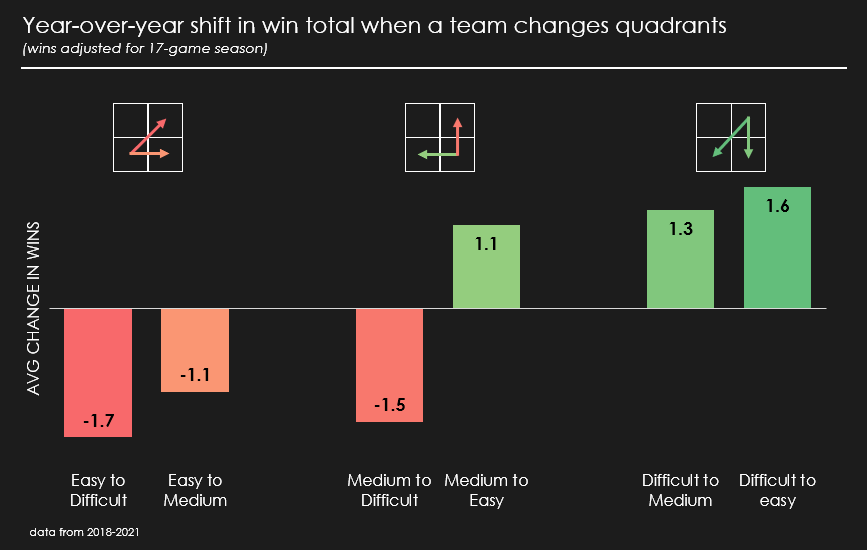
Case Studies
The 2018 Chicago Bears and the 2017 Jacksonville Jaguars are two examples of what can happen to a team with a combination of great health and an easy schedule. Both teams seemingly came out of nowhere to put up double-digit wins, win their divisions and then fade back to mediocrity or worse next season.
The Jaguars' Collapse
In 2016, the Jaguars only won three games and had the second-worst record in the AFC. It was their sixth straight season with a record below .500. They promoted assistant head coach Doug Marrone to head coach the next season, and he appeared to turn the organization around.
In 2017, Marrone led the Jaguars to the playoffs with a 10-6 record and a top-five finish in scoring offense and defense. But the 10-win season, the most wins the Jaguars had in a decade, was a mirage that quickly disappeared.
In 2018, the Jaguars moved back to their familiar place in the standings…last place, and they’ve been there every year since. Below is their pattern of wins in the two seasons preceding their playoff year and the two seasons after.
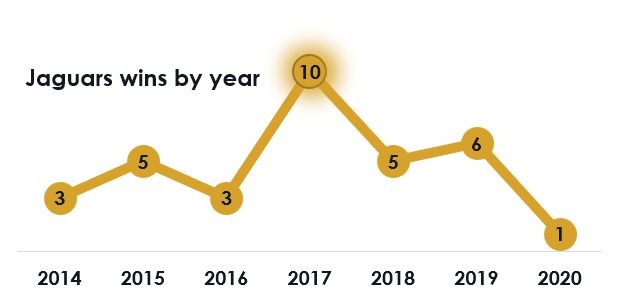
So, what happened? According to what you’ve read so far, you can probably guess the Jaguars had a favorable schedule and very few injuries. As usual, there were many changes. Players left, players joined, staff was shuffled around and in-game strategy changed. Still, we believe a considerable influence on this outlier season came from their combination of injury and schedule luck.
Blake Bortles ran the Jaguars' offense for five seasons, and they averaged a point-per-game rank of 26th in four of those seasons but ended up fifth overall in 2017. Their placement comfortably in the easy quadrant would have been a good indicator that regression was right around the corner.
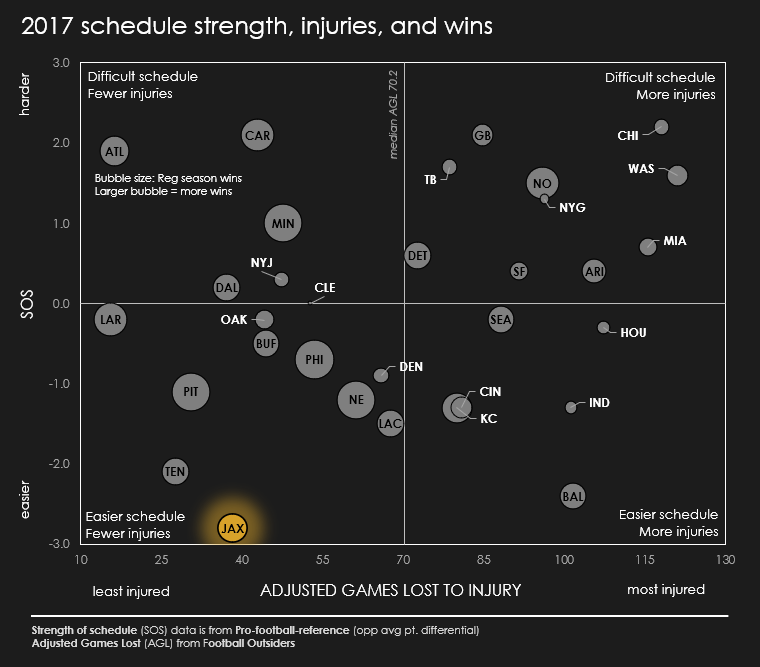
The Bears' Short Day in the Sun
After a dismal three-year stretch under John Fox, the Bears decided to let him go at the end of the 2017 season. In 2018, they brought in highly sought-after Chiefs offensive coordinator Matt Nagy as their new coach. Second-year quarterback Mitchell Trubisky took a big leap forward. The Bears added game-wrecking edge rusher, Khalil Mack.
The result was a seven-win improvement to 12-4 and realistic aspirations of going to the Super Bowl. The accolades poured in. Nagy was named the AP NFL Coach of the Year, Trubisky made the Pro Bowl and Khalil Mack was a first-team All-Pro. General Manager, Ryan Pace, the architect of the 12-win season was named the Sporting News 2018 Executive of the Year.
Although their season ended with the famous double-doink in the wild-card round, expectations coming off their 12-4 season were sky-high. But 2018 ended up being a blip. Just like the Jaguars before them, the clock struck midnight on the Bears, and their Cinderella story was over.
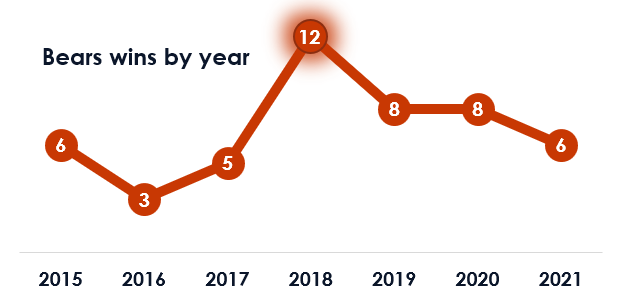
All the pieces seemed to be in place for sustained success. Nagy and Pace continued to lead the organization in 2019. Mack was still creating havoc behind the line of scrimmage. Trubisky, their young Pro Bowl quarterback was presumably just getting started on his rise. But what the Bears lacked after 2018 was the perfect storm of external factors helping to propel them to their success.
Their combination of injury luck and an easy schedule placed them into a tier of their own. Mediocre can become exceptional under these circumstances.
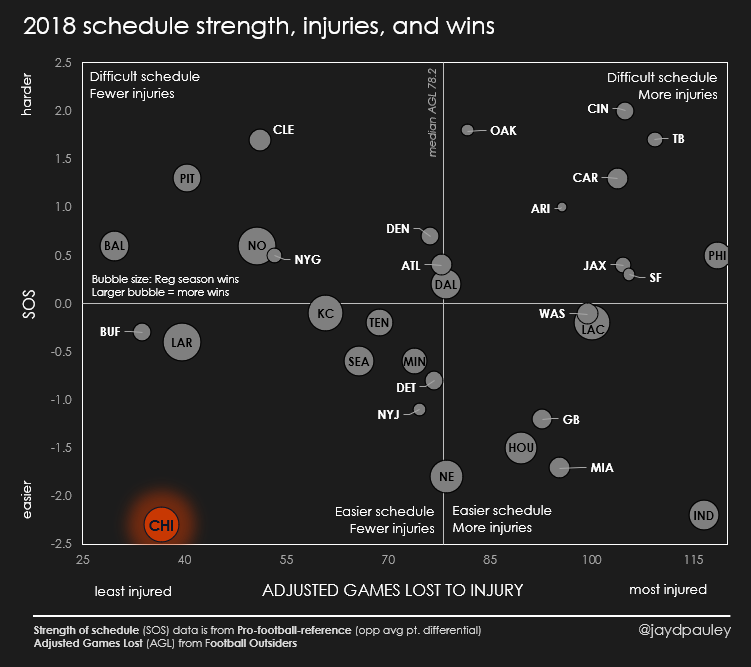
Correlation does not always mean causation. Every narrative based on correlation should be viewed with a degree of skepticism. These two examples of real-world scenarios help to support the high-level data we shared using a 4-year data set across 128 team seasons.
What does this mean for 2022?
We should expect to see about 40-50% of these teams move around into other quadrants, and their records should be influenced somewhat by this movement. Aside from additional changes to the roster, staff or play-calling on each team, we should also recognize the influence these additional factors may have on a team’s record.
The Ravens' luck should improve this season. Two years ago, they were an 11-win team, then they broke the record for most Adjusted Games Lost to injury (going back to 2001). It’s safe to say a bounce back to their 2021 win total shouldn’t be a surprise.
The Jets, Lions and Giants were all at or near the bottom of the league in the standings. Their place in the difficult quadrant played a role in their low win total. There’s nowhere to go but up for these teams. It’s possible their placement on the chart becomes more favorable and the gravitational pull of luck moves their record in concert.
All nine teams in the easy quadrant had a winning record; eight of the nine made the playoffs; the Dolphins are the only team to miss the playoffs. The Bills, Dolphins and Bengals were comfortably in the easiest positions last year. It’s unlikely they will have similar luck this year from the variables used for these quadrants, but it’s hard to envision too much regression from any of them.
Cincinnati has the incredibly talented duo of Joe Burrow and Ja'Marr Chase. Miami added Tyreek Hill and Terron Armstead, and the Bills have MVP candidate Josh Allen paired with the league’s top defense in points allowed. They are still on the rise and may continue an upward trajectory despite the possibility of their luck changing.
But it’s likely their path is more difficult this year. Perhaps, we see other teams in the “easy” quadrant such as New England, Dallas and Tennessee regress due to a more difficult path. The Titans end up in the easiest quadrant based on schedule strength and injury luck, but a third factor unlikely to repeat is also their +5 net wins from close games.
Overall Conclusions
It’s not guaranteed a team in the difficult quadrant will have a better record the next year, and vice versa for the teams in the other quadrant. However, the quadrant they are in can be used in combination with other key information to understand which teams are likely to improve and decline the next season. It can also help to explain an outlier season in the past.
Anomalous seasons that seem puzzling are often quite understandable when we take a closer look at some of the circumstances outside of a team’s control. Most NFL teams are very close to each other in talent. Often, what happens on the margins can be the difference between making the playoffs or ending the regular season in disappointment.
Our analysis suggests these two factors will shift a team’s record by 1-2 wins regularly, and by many more wins when both factors are at the extreme end of the scale.
Jason Pauley contributed to this report.


